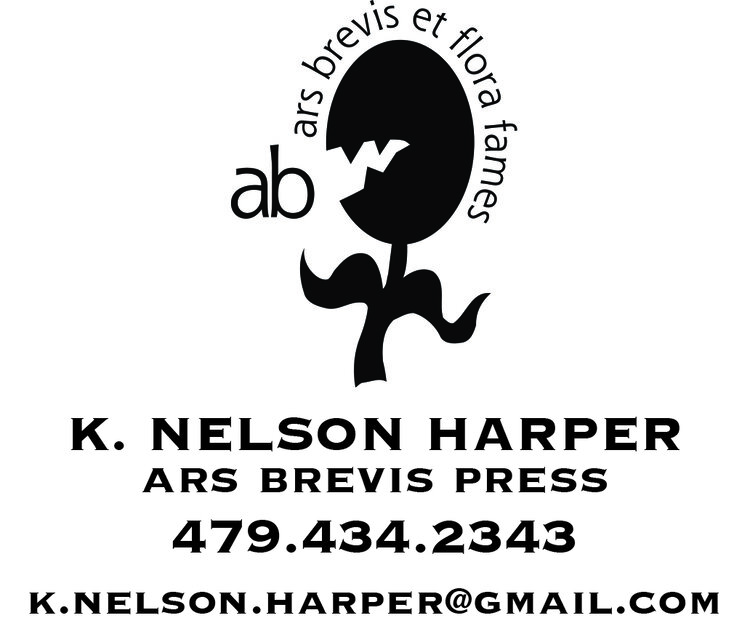Not your grandmother’s letterpress…
My work as an artist and educator explores the possibilities for visual expression that are rooted in the idea that design concepts and production methods, both old and new, can be used in fine art. I have conceived, designed and produced many artists books and broadsides under the press name Ars Brevis Press. (Ars brevis et flora fames: art is brief, and flowers are hungry. Just so.)
I have spent decades learning many different technologies, both old and new, and using whatever best serves the content. I often bridge the gap between old and new technologies, combining traditional letterpress and digital production techniques in the service of (usually humorous) art.
I also teach workshops in letterpress and book arts.
Email or call for more information: k.nelson.harper@gmail.com. or 479.434.2343
About…
Katie Harper teaches graphic design and printing/book arts at the University of Arkansas - Fort Smith. She holds a BFA in photography from the San Francisco Art Institute, as well as an MFA in book arts/printmaking from the University of the Arts in Philadelphia. Her background includes award-winning letterpress and book arts, with works represented in public and private collections around the country. She also has extensive experience in commercial graphic design and art direction, notably in print and editorial design. In addition to teaching innovative graphic design, Harper also directs Underground Ink, the letterpress/book arts studio at the University of Arkansas - Fort Smith.
ARTIST’S STATEMENT
Back in my misspent youth, I sat in my living room in San Francisco, listening to Brahms’ Second Piano Concerto. “If only I could create visual art that had such exquisite depths, such excruciating beauty,” I earnestly scrawled in my journal on that fateful night. And indeed, not long after that I produced Viewing Landscaping, an artist’s book about the perils of singing in a crowded elevator in San Francisco’s stuffy financial district. “This is a piece of cake!” I cried out joyously, and began to pursue even greater artistic heights (or sometimes depths) as a book artist.
I gave up my long quest for the elusive Grail of artistic fame, having at last realized that it just wasn’t in me, and instead I began to celebrate what was in me, believing firmly that Truth, like happiness, could come only from within and, contrariwise, whatever is within must be Truth. It seemed imperative somehow that I should share what I found with others, whether they wanted it or not.
“Humorous art, like poetry, has an extra content. It plays, like an active child, close to the big hot fire which is Truth. And sometimes the reader feels the heat.” —E. B. White
What White didn’t say (but which I quickly discovered) is that Truth is often accompanied by long-winded, boorish companions who inevitably force their way into the most well- intentioned works, but who—if one is to entertain Truth and keep it around for long—must also sometimes be tolerated with a sigh, like in-laws at Christmas.
Brighitta: But it doesn’t mean anything!
Fraulein Maria: So, we put in words, one word for every note, like this…
—Oscar Hammerstein II, from The Sound of Music
In my work, words often share equally with visual elements, and, like many book artists, I perhaps owe as much to poetry as, say, to abstract expressionism. Much of my work is heavily dependent upon literary influences; in addition to my own humble offerings, quotations from the great and the trivial often dot the pieces and are even occasionally credited. Influences from the visual arts are not so easily pinned down—there are doubtless many whose styles I have appropriated without acknowledgment because I have long since forgotten their names. I am greatly indebted to writers such as James Thurber, who once said of his own work, “It is impossible to read any of the stories from the last line to the first without experiencing a definite sensation of going backward.” Just so.
“…and the Devil whispered behind the leaves, ‘It’s clever, but is it Art?’ —Rudyard Kipling
The output of my artistic endeavors often puzzles and even sometimes irritates art pundits because it defies categorization and seems to lack weighty purpose, slithering like a greased pig around such terms as “post-structuralist dogma.” The general public, however, doesn’t give two figs for post-structuralist dogma; they rightfully feel somewhat ostracized from the arts when such terminology is bandied about, and they remain my target audience (until they start asking for something in blues and greens to go over the sofa). As for me, I love terms like post-structuralist dogma; of such stuff are a parodist’s dreams made.
However, I am not unmindful of the perilous tightrope upon which the light-hearted artist often treads.
“The world decorates its serious artists with laurels, and its humorists with Brussels sprouts.”—E. B. White
I await with cheese sauce in hand.


